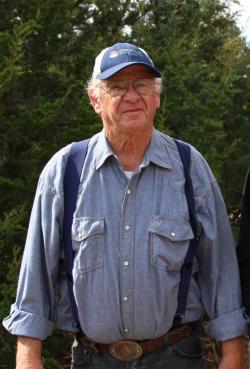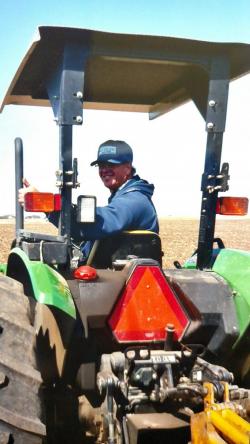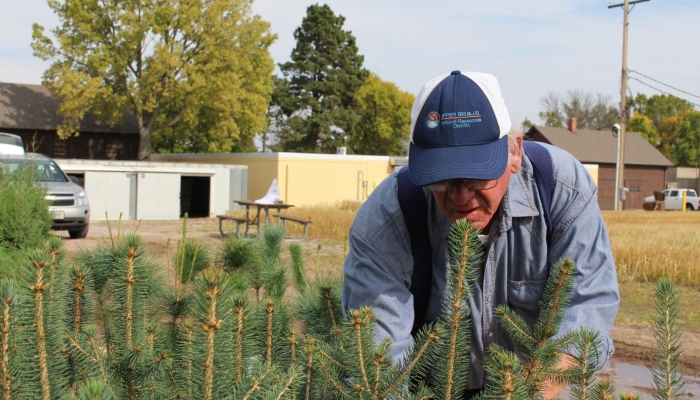A Passion for Planting
Feather to retire after 40+ years of forestry
If there’s one thing Ken Feather is really bad at, it’s sitting still.
The springy septuagenarian is constantly on the move, ready to build or plant or improve something. Don’t let his jokes and gentle voice fool you. He’s a man on a mission—one that’s seen him plant more than a million trees in the last four decades as the forestry department manager for the Upper Big Blue Natural Resources District. Feather has worked with farmers, homeowners, businesses, and municipalities to improve their world through the NRD’s tree programs.
 Despite all the work he’s done, he’s nowhere near satisfied. “There needs to be more trees planted,” he says, noting all the places that could use more wildlife habitat, more erosion control, more water filtration.
Despite all the work he’s done, he’s nowhere near satisfied. “There needs to be more trees planted,” he says, noting all the places that could use more wildlife habitat, more erosion control, more water filtration.
Feather began his career with the Upper Big Blue NRD in 1977 as an engineering technician. At that time, the NRD system in Nebraska was still quite new and there were only five other employees in the local office. He drafted water plans, issued irrigation permits, inspected dams, and started planting trees. Two years later, Feather moved into the role of forestry department manager, the position he would hold for the next 41 years.
The process of planting trees hasn’t changed much in that time, but there have been some advancements in technology that have impacted the work, such as satellite imagery that makes designing a planting project simpler and more precise. A major change in the work has been the decrease in demand for trees in agricultural land. In the last decade, the NRD has planted fewer than 20,000 trees per year. In the 1980s Feather and his team were planting 50,000 trees per year.
It’s getting harder and harder to convince growers to give up land that could be producing row crops for trees, Feather says. He encourages them to consider that pivot corners and fence lines are an easy spot to add trees and positively impact soil health and local wildlife populations. He also advocates for planting native grasses and shrubs in places where trees aren’t suitable.
In a related effort, Feather has worked for many years with the Rainwater Basin Joint Venture, which seeks to restore wetlands throughout the region for bird habitats. He started out serving on their Private Lands Workgroup and is now on the Management Board. He will receive an award for his decades of service from the Rainwater Basin Joint Venture in February.
It is only fitting that a guy with the name “Feather” should be so dedicated to habitat restoration. “This district needs to do more for wildlife,” he says emphatically. “I hear sometimes, ‘I don’t see many birds anymore on my land.’ Well, if you tore down my house, I’d move away too.” Planting trees, shrubs, and native grasses are an important part of rebalancing an ecosystem that has been disrupted by large scale agriculture, he says.
The biggest planting project Feather can remember working on in the district was when his team planted 5,000 trees on one property for a landowner who was dedicated to improving wildlife habitat. “That’s a once in a lifetime project,” he said. He’s also done some riparian buffers (stream bank improvements) of 2,000 to 3,000 trees, and many field windbreaks and farmstead shelterbelts, which generally have 100-200 trees and provide protection for crops, animals, and homes on the windy Nebraska prairie.

Feather has also worked with communities to plan tree plantings in parks and other public spaces, as well as to replace trees damaged by storms. In 2012 Feather was involved with helping Beaver Crossing recover from a powerful tornado on Mother’s Day that destroyed homes, businesses, and a great many trees. Replanting is an important part of the recovery process, for the land and wildlife, as well as the people, he says.
Feather has plenty to do in all seasons (he also manages maintenance at the five NRD recreation areas and the NRD office building, as well as the NRDs fleet of vehicles), but spring is by far his busiest time of year. The majority of NRD tree planting happens in April and May. In 43 years of this work, he’s planted in all weather conditions from sleet and snow to scorching sun. Cold weather is no picnic for planting, but hot weather is the worst, as it is hard to keep the trees moist enough to survive. “You’ve got to keep the roots from drying out, otherwise you’re just going to plant a dead tree,” he said.
Despite the challenges, Feather has enjoyed his career with the NRD, especially the opportunity to meet with the public. It’s not just planting skills, you must also possess people skills to do this work, he says. Whether he’s visiting with campers at a recreation area, providing information to the public about tree health, or meeting with individuals to design a project on their property, Feather loves to share what he’s learned and improve communities throughout the district.

Retirement will be a challenge for Feather, who still sees much to be accomplished in the district. On the other hand, retirement does mean being able to spend more time with his grandchildren and his fishing rod, and there are some projects he’d like to tackle and a few places he’s always wanted to visit. Slowing down doesn’t interest him, but shifting his energies to new directions might. In retirement, he plans to continue to spend a good bit of time at the NRD recreation areas and perhaps assist with spring planting activities. After all the effort he has invested in his tree planting mission, it will not be easy to turn the tractor keys over to someone else.
Rod DeBuhr, assistant general manager of the Upper Big Blue NRD, has worked with Feather since 1979 and will proceed him in retirement by only a few weeks. “I have never known a kinder and more dedicated person than Ken,” said DeBuhr. “All of us who have worked alongside him appreciate what he has done through the years.”
A retirement open house honoring Feather’s career with the NRD will be held on Thursday, January 16, from 4 to 6 p.m. at the Upper Big Blue NRD office (319 E 25th St, York). The event will be a chance for the public to recognize Feather’s many years of public service and to thank him for his dedication to the people, the wildlife, and the land of the district.

